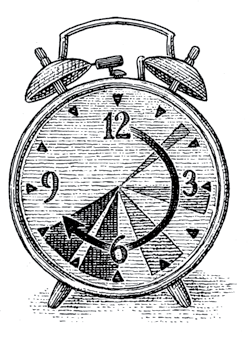A Field Guide to Lucid Dreaming (16 page)
Read A Field Guide to Lucid Dreaming Online
Authors: Dylan Tuccillo,Jared Zeizel,Thomas Peisel

Remember Rapid Eye Movement (REM), that stage of sleep
where your brain is completely active yet your body is asleep,
the time in which we dream? To learn lucid dreaming this stage
is incredibly important. The goal is to direct all your energy at
REM, to focus your intention on those open windows of time
when you’re actually dreaming.
Here’s the problem.
When we set an intention before bed, we don’t hit a substantial
period of REM for nearly an hour after falling asleep. There are
three stages of sleep you go through before even getting to REM.
Your intention has to wait in line for light sleep and deep sleep to
pass by before it gets its chance to shine.
Often enough, as we enter REM, we’ve forgotten our original
plan: to have a lucid dream. Your goals to see a dream sign or
to perform a reality check will continue to fade as you progress
through additional sleep cycles.
If only there were some clever, simple solution to this problem,
a way to go to sleep right into a dream, bypassing the amnesia of
deep sleep! Don’t panic, there is a way.
Wake-Back-to-Bed
The last two windows of REM occur at the end of our sleep
cycles, in the early morning hours. Although we dream on
and off throughout the night, lucid dreamers tend to focus on
these last two stages for a couple reasons:
=
101
<


They’re the longest.
As the night progresses, the amount of time
you spend dreaming increases. The last two stages of REM are the
longest—nearly fifty minutes each—giving you a great chance to
have long, vivid, conscious dreams.
No more deep sleep.
Since you’ve already gotten your deep sleep
over with earlier in the night, the only thing that lies between the
last two stages of REM is a small sliver of light sleep. Your body is
still tired, but your mind is primed for dreaming.
Easier to remember.
Subjects waking up directly out of a dream
have better dream recall. Focus on these last two stages of sleep
and it’s likely that you’ll remember your lucid dreams directly after
waking.
Armed with this knowl-
The first lucid dream I had was spontane-
edge, let’s trick Mother
ous. It was one of the most memorable
Nature by catching our last
moments of my life. I was camping at the
two REM cycles. This feat
time and had spent the day by my tent
is done with a technique
reading a book. I had felt quite meditative
all day, but other than that I had not tried
known as wake-back-to-
any technique either during the day or as
bed. Simply put, it involves
I was falling asleep, it just happened out of
waking up after six hours
the blue at about 4:00 a.m. Like I said, it
of sleep, staying awake for
was one of the most amazing experiences
twenty minutes, then going
I ever had, waking up in a “dream world”
back to bed. This thrifty
being fully awake in that world, spinning
solution sends you back to
and jumping around in excitement, unbe-
lievable excitement. —Jack G.
bed right before you enter
the last windows of REM.
=
102
<
How to Catch Your Last REM Cycle
By waking up just before your last REM cycles begin, you’re
essentially putting your sleep on “pause.” When you go back
to bed twenty minutes later, you’ll be diving right into a nice,
refreshing swimming pool of your own dreams. With wake-back-
to-bed, setting an intention, looking for dream signs, and focusing
on becoming aware in your dreams becomes very effective. Here is
the step-by-step technique:
Step 1: Set Your alarm for Six Hours after Bedtime
Wake up around six hours after you go to sleep. This tends to
be a reliable number, but results may vary. If your early morning
wake-up time isn’t working, try variations. For example, if you’re
sleeping for a total of eight hours, maybe you’d want to try to catch
the very last REM cycle, so you’d want to set your alarm for seven
hours after your bedtime, not six. If you have difficulty returning
to sleep after a wake-back-to-bed, stick with six hours; it will be
easier to fall back asleep with this option.
Step 2: Wake Up for Twenty Minutes
Wake up and stay up for around fifteen to twenty minutes. Staying
awake for this span of time awakens your left brain, the analyti-
cal half of your mind, which is essential for realizing that “Whoa,
this is a dream!” Without your active left brain there to help, your
creative right brain will happily get carried away in the whimsy of
the dream. In other words, you don’t want to simply wake up for
a few seconds and fall back to sleep. We know, your bed looks so
=
103
<

cozy you could just cry. But this tech-
nique is basically pointless unless you
stay up, get your brain thinking clearly
and logically, and then go back to bed
with a strong intention.
Step 3: Go Back to Bed
Now you can get back into bed and
ooze into a state of comfortable relax-
ation. Many have found that sleeping on
your back helps with lucid dreaming, so we
recommend that you try this position. As you fall back to sleep,
you want to focus your mind on your intention: “I will realize that
I’m dreaming.”
Step 4: affirm It
Tell yourself over and over “I am aware that I’m dreaming.” Let
this be your dominant thought as you fall asleep.
Step 5: See It
Behind your closed eyelids, visualize yourself inside a dream. See
yourself becoming lucid and realizing that you’re dreaming.
See yourself noticing a dream sign or doing a reality check. Imagine
it with all of your five senses. The stronger the visualization the
better.
=
104
<

Step 6: Feel It
Feel the excitement and emotions that come with being lucid in a
dream, when you stop and perform a reality check only to realize
that you are in fact dreaming. Feel the incredible freedom of being
aware—without boundaries or limits—inside a dream.
Step 7: Expect It
As you repeat the phrase “I am aware that I’m dreaming,” you will
begin sinking into sleep. Remember, you’re not simply turning off
like a robot, you’re an explorer on a journey to your own inner
universe. An incredible adventure awaits you. The next place you’ll
find yourself in will be a dream.
THINGS TO DO IN THE FIFTEEN TO
TWENTY MINUTES WHILE AWAKE
• Read past dreams from your dream journal.
• Look over your list of dream signs.
• Read this book (or another book about lucid dreaming if you must).
• Take a pee.
• Draw a picture of a dream you’d like to have.
• Get up and walk around.
• Write a letter to your subconscious.
• Continuously ask yourself “Am I dreaming?” until you go back to sleep.
=
105
<


Eureka! You’re In.
Welcome to Wonderland! You’re Alice and you just hit the
floor of the rabbit hole. The moment that you recognize
that you’re dreaming will be an exciting one, so give yourself a big
pat on the back for this accomplishment. If this is your first lucid
dream, then it’s likely you now know what all the fuss is about.
The experience is profound—you’ve just discovered a completely
uncharted terrain.
CAT NAP
